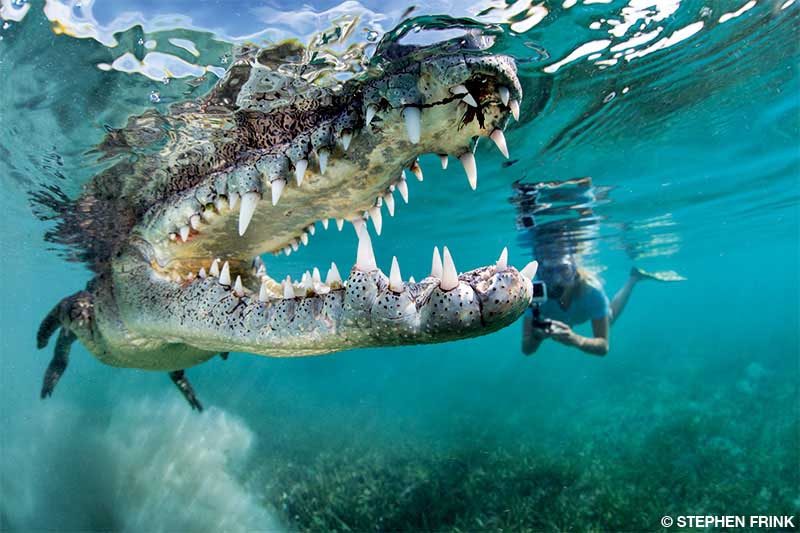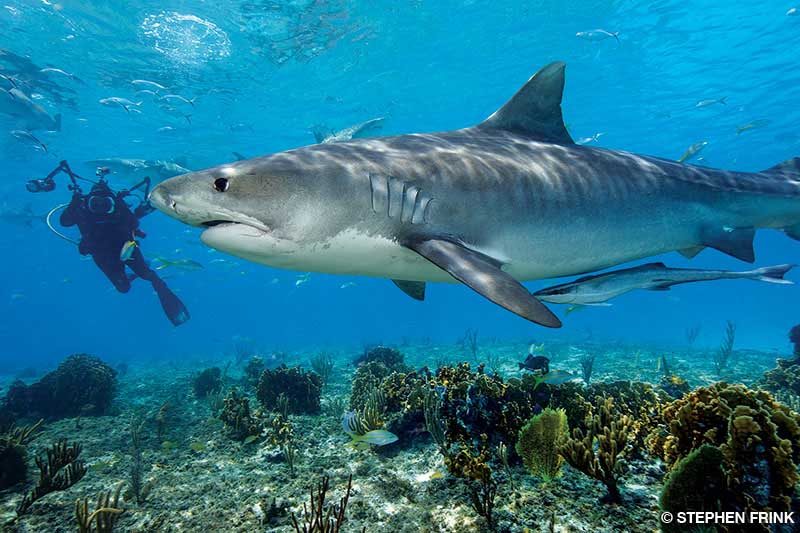Underwater photographers usually evolve a specialty, but the first fork in their road typically involves defining an interest in either photographing natural history — marine life in particular — or concentrating on editorial and commercial work that inevitably involves photographing people underwater.
My career has been a bit of a hybrid. Most of the images I’ve shot on assignment for magazines and dive equipment catalogs were wide-angle work with divers, while I often photograph marine life purely for fun. Photos of charismatic marine life, however, help tell the story of a dive destination or might be used for photo décor or stock photography. Compositions that illustrate people interacting with marine life bridge both disciplines and combine each approach’s rewards and challenges.

Composition
Photographers may plan to have a diver as a significant part of the composition, ideally working with an underwater model who is cognizant of the photographer’s directions. That’s the way I prefer to work. It begins with communication on the boat so the model clearly understands my underwater signals and the shoot’s objectives. We can’t speak while diving, and writing instructions on a slate is too time-consuming, so we work out hand signals that confirm where I want the model positioned in the frame, whether we are shooting a vertical or horizontal format, how close the model should be to the marine life and where the model should focus their eyes.
Having a diver in the composition can also be serendipitous. The photographer might be in the right place for the marine life and lucky enough to have a diver conveniently swim into the frame. That is less productive than a controlled and replicated composition, but sometimes it is the best we can hope for. In either case, it helps to previsualize the composition and position of the marine life, which is usually in the foreground.


When I see a creature that might be amenable to a diver’s approach, I first think of two things: the shoot zone and the field of flight. Water is more than 800 times denser than air and has a cool color cast (usually cyan or green). To get good color generally requires using an artificial light (strobe), which has the greatest effect less than 4 feet from the subject. The size of the subject relative to the lens’ angle of view defines the shoot zone. Wide-angle zooms are more forgiving in refining the composition, but there will be an optimal distance from any subject in terms of composition, which needs to be near enough to get good color and resolution through the water column.
The field of flight, which is the finite distance we can approach without scaring the fish, will influence the optimal distance. A careful approach is helpful, but the marine life will ultimately set the pace of the encounter. A fish at a cleaning station is often more tolerant of proximity, while fish acclimated to visitors within a marine protected area can likewise be far more forgiving. Tolerance is important in the marine-life-with-model paradigm, for not only does the photographer need to get near, but the model also needs to appear in the frame. A distant silhouette model won’t scare the fish, but their position must be much closer for intimacy and eye contact. With the fish sandwiched between the photographer and the model, everyone’s approach needs to be exceedingly stealthy and benign. Some fish, however, sometimes couldn’t care less. Those are the most special encounters.
Perspective Distortion
While it is possible to photograph smaller fish as part of a diver portrait while using a macro lens, diver-with-marine-life shots generally use a wide-angle lens, which can often make subjects nearest the lens seem unnaturally large relative to the background diver. Sometimes it can be a compositional benefit, as with the great white shark with the cage in the background.

I shot that image using a 14mm wide-angle lens, with my camera mounted on a pole protruding from my cage. When the shark swam very near my camera, it looked immense relative to the scale of the distant cage. The British tabloids published and sensationalized this photo as if it were of the world’s largest great white shark. Any experienced underwater photographer would recognize it for what it is: perspective distortion. The diver in the background can provide dramatic scale, enhancing an already impressive creature.
Some of those same tabloids published the shot of a crocodile in Jardines de la Reina, Cuba, with my daughter in the background and ran it with a caption to the effect of, “Underwater photographer places young daughter in peril with fierce saltwater crocodile, all for the sake of a photograph!” Obviously, that’s not what happened.


Eye Contact

Nothing will spoil a great composition more than to have an astonishing marine creature in the foreground while the diver model is staring right into the camera’s dome port, totally indifferent to the wonder before their eyes. The best models will have an intuitive sense of where to look so that when the viewer later examines the photograph, the diver’s eye contact will reinforce visual involvement with the main subject.
In one of the illustrative photos, my model saw me set up my camera and strobes pointed at the large stand of pillar coral, but she couldn’t see the action between the queen angelfish and Spanish hogfish at the cleaning station. She realized something was happening, however, and kept her eyes cast in that direction, trusting that I would catch the decisive moment.
With the spotted dolphins, the interaction would inevitably be brief. For the short time when both model and photographer could keep up with the dolphins, I had to ensure that my perspective allowed the snorkeler to appear visible and engaged.
Behavior
Behavioral photo shoots are hard to predict. You might be familiar enough with the subject to know something could happen, but the best you can hope for is that both photographer and model are in position if it does happen.
I’ll typically set up in front of the primary subject and begin a series of photos. If the fish tolerates my presence, I’ll photograph the model first as a distant compositional element, never knowing how long the interaction may last. If the fish shows no alarm, I will bring the model closer and closer until we both sense that the encounter would terminate if we closed in further. I will then signal for my model to hold their position without touching the coral or stirring up sediment in the background that could ruin the photo with backscatter. Having a strobe that recycles quickly is a blessing in situations like this, where the action is fleeting and catching unusual behavior is paramount.

Photographer at Work
Having other photographers on the scene is a mixed bag. Sometimes there is only one sweet spot to photograph marine life, and competing for that perspective is often annoying and nonproductive. Another photographer at work, however, can be interesting for providing scale and human interest. They have the reciprocal advantage of having you in the frame for the same reason. The best case is when each photographer takes away their eye from the viewfinder and concentrates on modeling for the other. Remember, their photo is every bit as important to them as your photo is to you, so trading off a bit of attentive modeling is a small price to pay for a compelling photographer-at-work shot.
Ball of Sun

Digital camera sensors usually have a hard time holding detail when shooting into bright sunlight, and photographers often try to obscure or diffuse the effect. The underwater model’s body is a good device to obstruct the brightest sunlight, which provides the corollary advantage of putting the diver in a stark silhouette. A skilled model will know about the sunlight issue and position themselves accordingly.
The image of the sea fan is part of a series I shot with my wife in the Solomon Islands. When we got back aboard and I was editing images from the day’s dive, I commented on how lucky we were to get nearly every shot with her in the middle of the ball of sun. Only then did she reveal that she could see her reflection in my dome port, knew what I was going for and why, and maneuvered herself to make it happen.
Collaborations like this — between photographer, model and fish — are some of the most rewarding in underwater photography.
© Alert Diver — Q1 2021